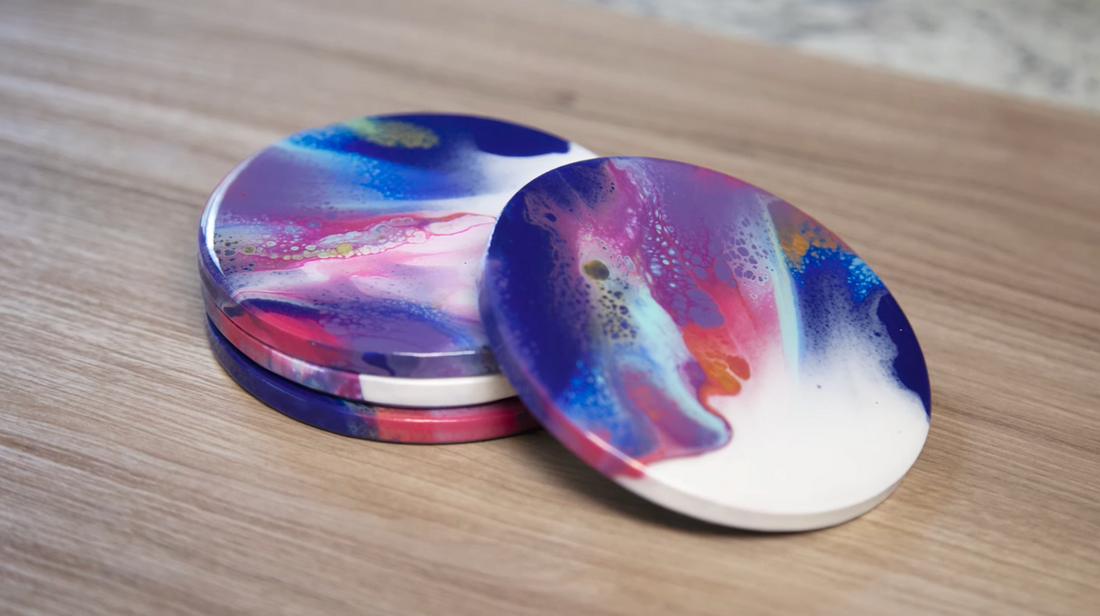Have you ever wanted to try your hand at acrylic pour art? Coasters are a great way to get started with this colorful paint technique, and their manageable size makes them a fun, quick, and easy project.
Artist Sarah Hunyadi is a mixed media artist based in Columbus, OH who specializes in fluid art, creating coasters, charcuterie boards, trays, wall art, and other home decor items.
In this tutorial, Sarah demonstrates how to create acrylic pour coasters, complete with a glossy resin topcoat to seal and protect, and a cork backing for a professional looking finish. Sarah guides us through each step of her simple "Press and Flip" process, sharing her favorite supplies and tips along the way. While her techniques are beginner-friendly, they deliver impressive results. You'll learn how to create acrylic pour coasters that you can proudly gift, sell as part of your resin business, or enjoy as a beautiful piece of handmade decor in your home.
Let's get started!
What You’ll Need:
- Ceramic coaster rounds (choose coasters that come with cork backings)
- Acrylic paint in 5 colors (3 colors, plus white and gold)
- Floetrol (or pouring medium of your choice)
- Paper cups & stir sticks for each color of paint
- Silicone mat
- Stands to set the wet coasters on (plastic cups work well)
- Palette knife
- Contact shelving paper or painter's tape
- ArtResin
- Plastic liner to cover your work surface
- Gloves, plastic mixing cup and plastic stir stick
- Maker's Studio Torch
- Dust cover
- Heat Gun
1. Prepare The Paint
When it comes to a successful acrylic pour, paint consistency is key. If the paint is too thick, the colors can't blend to create the interesting patterns acrylic pours are known for. Aim for a fluid, cream-like consistency: as the paint runs off the stir stick into the cup, you should see a slight mound that quickly disappears.

To achieve the ideal consistency, use a 3:1 ratio of Floetrol to acrylic paint. In a plastic cup, add 1 part acrylic paint. If the paint is very thick, such as heavy bodied acrylic paint, thin it out with a bit of water or a more fluid acrylic paint in the same color.


Next, add 3 parts of Floetrol (or your chosen pouring medium) and mix well. The pouring medium promotes the formation of cells and ensures the paint dries evenly and smoothly without cracking.

Mix until smooth, ensuring there are no lumps. You can prepare as much or as little paint as you need, as long as you maintain the 3:1 ratio.
💡 TIP: For more information on how to prepare paint for acrylic pours, watch Sarah's video Acrylic Pouring For Beginners.

2. Pour The Paint
Start by applying the paint onto the silicone mat in a random pattern, one color at a time. To reduce paint waste, form a circular shape with the paint, making it slightly larger than the coaster. This ensures there will be enough paint to cover the sides effectively.





Once you've applied each color, finish with a little more white.

2. Drop, Press & Remove The Coaster
Gently drop the coaster, face down, into the paint.

Gently press down until you see the paint rising along the sides of the coaster.

Carefully lift the coaster and place it on a stand.


3. Tidy The Edges and Bottom
Using a palette knife, go around the coaster gently pulling the paint down onto the sides to cover any bare spots. Be careful to maintain the pattern and paint color as much as possible. If needed, collect extra paint from the silicone mat.


Then, move to the bottom of the coaster and use the palette knife to scrape off any excess paint.

4. Prepare The Remaining Coasters
For the second coaster, apply the paint as you did in Step 2, one color at a time. This time, apply the paint directly beside the paint used for the first coaster. You can re-use some of the paint from the first coaster, but ensure it's no more than half. 




Carefully place the second coaster into the paint, being mindful not to lay more than half of it into the paint from the first coaster.
💡 TIP: Avoid placing too much of the blank coaster into the used paint. The paint colors will blend together, losing the pattern and you could end up with a muddy mess.

Use your palette knife to gently lift paint from the mat directly onto the coaster sides, if you notice that gently pressing the coaster into the paint doesn't cover the edges.


Carefully lift the coaster off the mat and place it onto a stand to dry.
Repeat the process with the remaining coasters, applying the fresh paint next to the paint used for the previous coaster.

If the used paint appears too muddy, apply fresh paint to a separate, clean area of the mat.
After tidying up the edges and bottoms of the coasters, set them on the stands to dry for approximately 24 hours. Resist the temptation to touch the paint before then or you may disturb the pattern.
__________________________________________________________________________________________
3 Ways To Re-Purpose Extra Pour Paint
1. Keep a collection of acrylic blanks on hand, such as Christmas ornament shapes, to drop into the paint.
2. Allow the paint to remain on the silicone mat. Once it dries, peel it off and repurpose the acrylic skins in future art projects.
3. Scrape the wet paint off the mat into a cup or squeeze bottle, letting it become whatever color it decides it to be. Use it on a future pour project.

____________________________________________________________________________________________
5. Prepare The Coasters For Resin
Inspect the coasters thoroughly after the paint has dried. Touch up any areas that you feel may need it, allowing the paint to fully dry once again.
Next, we need to protect the back of the coasters from resin drips. As gravity pulls the resin down, drips will form along the bottom of the coaster which will need to be sanded out. To avoid this, mask off the back of the coaster with adhesive contact shelf paper. Trace the coaster onto the shelving paper, cut out a circle for each coaster, and apply it to the back. Trim off excess with scissors. Alternatively, you can use painter's tape to mask off the back of the coaster instead.


6. Apply The ArtResin
A glossy top coat of ArtResin will not only seal and protect the paint from scratches, but will also saturate and enhance the color and design.
While wearing gloves, prepare the ArtResin according to the label directions: equal parts of resin and hardener, measured by volume, poured into a plastic or silicone container.
💡 TIP: To coat 4 coasters, Sarah used 2 fl oz of resin mixed with 2 fl oz of hardener, for a total of 4 fl oz.
Mix the resin and hardener together for 3 minutes. Scrape the sides and bottom of the mixing container to ensure everything is incorporated.
Pour equal parts of the resin mixture into the center each coaster, one at a time.
Rotate the coaster to spread the resin evenly, using your gloved hand to smooth it over the sides. Alternatively, you can use a craft stick to spread the resin.


Lightly torch out the bubbles.
Cover with a clean plastic tote or a clean cardboard box that has had the flaps cut off. Allow to cure until the resin is dry to the touch, approximately 24 hours.

7. Finishing Touches
Next, carefully remove the contact paper from the back of the coaster. Place the coaster, paint side down onto a soft surface, such as paper towel. Lightly run a heat gun over the back of the coaster to soften the resin drips. Use a pair of tweezers to help peel the paper from the back of the coaster.


Since the cork backing doesn't cover the entire coaster, paint the perimeter of the back with the darkest color of paint you used to create your design. Allow the paint to dry.
Finally, apply the adhesive cork backing to the coaster.
💡 TIP: For a professional-looking finish, stamp the cork backing with your business name or logo.


We hope you found this tutorial helpful, and feel inspired to make acrylic pour art coasters of your own!
To see more of Sarah's work:
Please visit her website: www.chromayadi.com
Follow her on Instagram: @chroma_yadi
Watch her on YouTube: @ChromaYadi
ArtResin: Made For Artists, By Artists.

